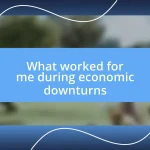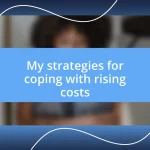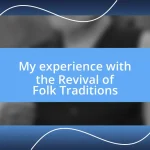Key takeaways:
- Participating in local clean-up drives and community meetings fostered a sense of belonging and highlighted the importance of collective action for sustainability.
- Attending workshops on renewable energy and engaging in advocacy significantly deepened the author’s commitment to environmental policies and local initiatives.
- Sharing knowledge through workshops and resource exchanges empowered others and reinforced the importance of community collaboration in the green movement.

Introduction to the Green Movement
The Green Movement is more than just an environmental initiative; it represents a collective response to the urgent call for sustainable living. I remember the first time I participated in a local clean-up drive. Standing there among a group of passionate individuals, I felt a sense of camaraderie and purpose that I hadn’t experienced before. It made me question: how often do we take for granted the beauty of our surroundings?
Understanding the essence of the Green Movement requires recognizing its roots in social awareness and activism. When I started learning about climate change and its devastating effects, it struck me how interconnected our world truly is. This isn’t just about saving the planet; it’s about our health, our future, and the legacy we leave for generations.
As I became more involved, the movement unfolded into a tapestry of diverse voices advocating for change. Each encounter brought fresh insights, like talking to a neighbor who transformed their yard into a thriving garden. It’s inspiring to think about how individual actions can ripple outwards, sparking a larger dialogue about sustainability and our responsibility—what choices are we making today that will shape our tomorrow?

My Personal Journey to Activism
My first true step into activism came when I attended a workshop on renewable energy. Sitting among fellow enthusiasts, I felt an electric buzz of inspiration. Their stories of solar panels and wind turbines ignited a passion in me that I hadn’t fully acknowledged until then. I remember leaving the workshop with a newfound commitment—not just to educate myself, but also to spread the word. Have you ever felt that rush of excitement when you know you’ve found your calling?
A pivotal moment in my journey was during a community meeting about reducing waste. I shared my experiences of starting a compost bin in my apartment, a small but impactful step. The applause and support from the room filled me with a deep sense of belonging. It reminded me that change often starts small, and sharing our journeys can empower others to take action too. Isn’t it remarkable how our collective efforts can build an unstoppable momentum?
Over time, I have come to realize that activism is an evolving journey. Each action feeds into the next, creating a path that’s uniquely ours. For me, it has shifted from mere participation to a lifestyle woven into my daily choices, like opting for reusable bags or advocating for local businesses committed to sustainability. I often ask myself: how can I further integrate this ideology into my life? The answers keep unfolding, urging me to dig deeper and engage with the world around me.
| Stage of Activism | Personal Experience |
|---|---|
| First Workshop | Felt inspired by others’ stories of renewable energy. |
| Community Meeting | Shared my composting experience and received overwhelming support. |
| Ongoing Journey | Embraced sustainable choices as a part of my lifestyle. |
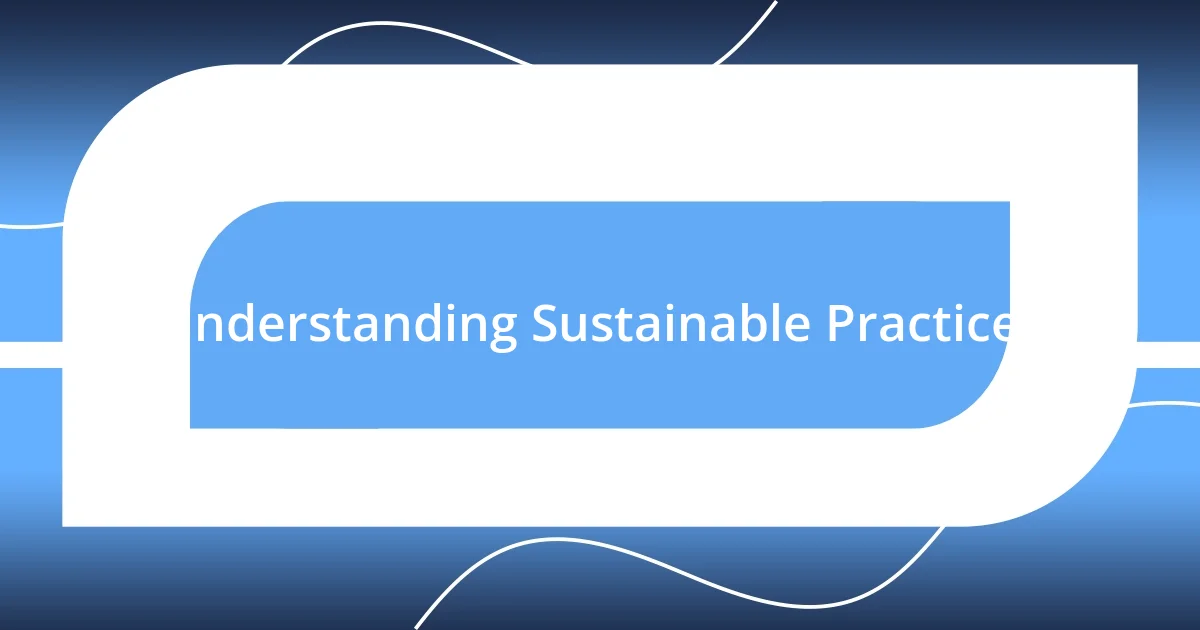
Understanding Sustainable Practices
Sustainable practices have become integral to our everyday lives, shaping how I view my impact on the world. I recall the first time I intentionally chose to support local farmers—walking through a bustling farmer’s market was a revelation. The vibrant produce, the friendly vendors who passionately discussed their farming methods, made me realize the power of supporting local economies. It’s more than a purchase; it’s a commitment to sustainability and health, knowing where my food comes from and how it’s grown.
Here are some sustainable practices that I’ve incorporated into my lifestyle:
– Reducing plastic use: I switched to glass containers for food storage and always carry a reusable water bottle.
– Mindful consumption: I prioritize quality over quantity, purchasing items that are durable and ethically produced.
– Energy-efficient choices: At home, I installed LED bulbs and started unplugging devices when not in use, noticing a drop in my energy bills as well.
– Compassionate transportation: I often bike or use public transportation instead of driving, not only cutting my carbon footprint but enjoying the fresh air at the same time.
Engaging with these practices has enriched my life in ways I hadn’t imagined. When I’m at home preparing a meal from the local market, I feel connected to my community and the earth. Each choice adds a layer of meaning, reinforcing the importance of sustainability in our journey together.
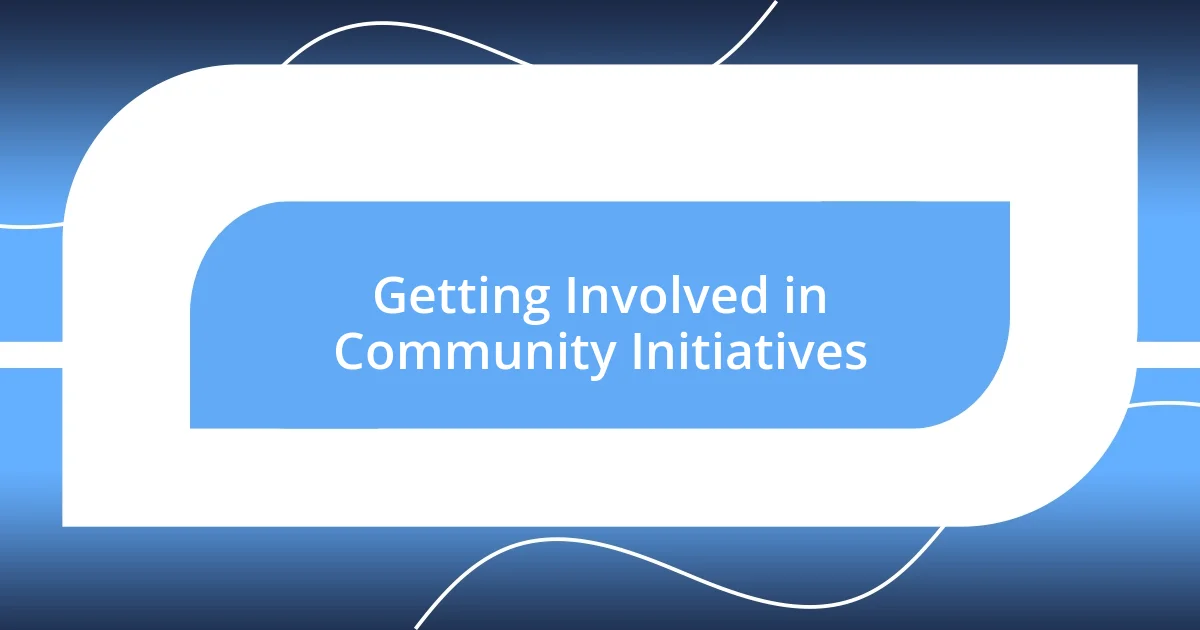
Getting Involved in Community Initiatives
Getting involved in community initiatives has proven to be eye-opening for me. One of my cherished memories is a neighborhood clean-up day. Armed with gloves and a trash bag, I joined hands with families and friends, transforming a litter-strewn park into a vibrant green space. As we picked up garbage, I felt a genuine connection to my neighbors, all of us unified by a common goal. Doesn’t it feel fantastic to see immediate results from your efforts?
Participating in local tree-planting events has become a regular activity for me. Each time I push a sapling into the soil, I’m struck by the thought that I’m contributing to our planet’s future. I still remember the excitement I felt when one of the trees I planted years ago started flourishing. The sight of its leaves swaying in the breeze made me reflect on how our small actions can grow and provide shelter and beauty for future generations. Can you imagine how much life a single tree can support?
I’ve found that joining forces with local advocacy groups brings a new layer of camaraderie to the cause. Whether it’s attending town hall meetings or participating in awareness campaigns, these gatherings fill my heart with hope and determination. Sharing stories with passionate individuals reminds me of the collective strength we possess. It’s a constant reminder that we aren’t alone in this journey; together, we can ignite change and inspire others to take part. How often do we underestimate the power of our united voices? I’ve learned that every little bit counts, and together, we can make our communities thrive.

Advocacy for Environmental Policies
Advocacy for environmental policies has shaped my understanding of how our voices influence change. I vividly remember attending my first city council meeting, nervously clutching a stack of notes on climate action. When my turn came to speak, the adrenaline rush was overwhelming, but I was determined to share my thoughts on reducing our city’s carbon footprint. Witnessing how local policies are crafted gave me insight into the importance of community involvement—our voices matter, and they can drive significant shifts.
One impactful experience was attending a rally focused on plastic waste reduction. Surrounded by passionate advocates, I felt the energy in the air—as if we were all connected by a single purpose. Listening to experts speak about the devastating effects of plastic pollution challenged my views and motivated me to push for policy changes. It sparked a fire in me to write letters to my representatives, urging support for comprehensive legislation. Can you believe how empowering it is to realize that our elected officials genuinely listen when we stand united?
Additionally, I’ve found that collaborating on grassroots campaigns is incredibly rewarding. I once joined a group that lobbied for green infrastructure in our city—transforming gray spaces into thriving ecosystems. The thrill of gathering signatures and sharing our vision with fellow citizens was electric. The more I engaged, the more I understood that advocating for environmental policies isn’t just about fighting for the planet; it’s about creating a better quality of life for everyone. Has it ever struck you how each small victory can cascade into larger policy changes? I’ve seen it happen firsthand, and it’s inspiring!

Sharing Knowledge and Resources
Sharing knowledge and resources within the green movement has been one of my most fulfilling experiences. I recall hosting a small workshop in my living room, inviting friends and neighbors to learn about composting. As I demonstrated how to create nutrient-rich soil from kitchen scraps, I could sense the excitement in the air. It was remarkable to see those light bulbs go on over people’s heads, realizing how simple changes could impact our environment positively. Have you ever experienced that satisfaction of imparting skills to others?
In my journey, I’ve also tapped into community resource-sharing platforms. I remember the day I discovered a local exchange where people could borrow tools or swap seeds. Instead of rushing to buy new gardening tools, I found joy in sharing and bartering with fellow enthusiasts. The conversations around that exchange were gold; we discussed our gardening trials, celebrated successes, and even shared secrets about pest control. It made me feel connected not just to resources, but to a community nurturing our green passions together. Isn’t it amazing how sharing can inspire us to learn and grow collectively?
Moreover, I’ve had the privilege of engaging in mentoring opportunities. One summer, I volunteered with a youth program focused on environmental education. Guiding young minds as they explored nature and discussed sustainability feels like planting seeds of change for the future. I can’t express how fulfilling it is to witness their enthusiasm as they discover that they can make a difference. Have you ever realized that by sharing knowledge, you not only empower others but also amplify your own commitment to the cause? It’s a powerful cycle that fuels us all in this movement.

Measuring Impact and Progress
Measuring impact and progress in the green movement can sometimes feel like a daunting task, but I’ve learned that it doesn’t have to be. I remember when my group organized a local clean-up event, and we decided to track the amount of litter collected. At the end of the day, standing among the bags of trash we had gathered, I couldn’t help but feel proud. It was tangible proof that our efforts were making a difference. Have you ever experienced that moment of clarity when seeing raw data turn into meaningful results?
I also find that utilizing surveys and feedback forms can provide invaluable insights into the efficacy of our initiatives. After leading a series of tree-planting workshops, I sent out a simple questionnaire to participants. The responses revealed not only their newfound enthusiasm for trees but also a desire for more hands-on projects. These insights helped me adapt future workshops based on what resonated with them. Isn’t it fascinating how listening to our community can refine our approach and amplify our impact?
What really stands out to me is the power of storytelling as a measuring tool. When I joined a campaign advocating for improved public transportation options, we gathered personal testimonies from commuters about how transportation barriers affected their lives. Sharing those stories in our presentations brought raw emotion to the statistics. It created a human connection that transformed numbers into compelling narratives, highlighting the critical need for change. Have you ever considered how stories can bridge the gap between abstract data and real-world impact? That’s how I see progress—through the eyes of those affected by our actions.



